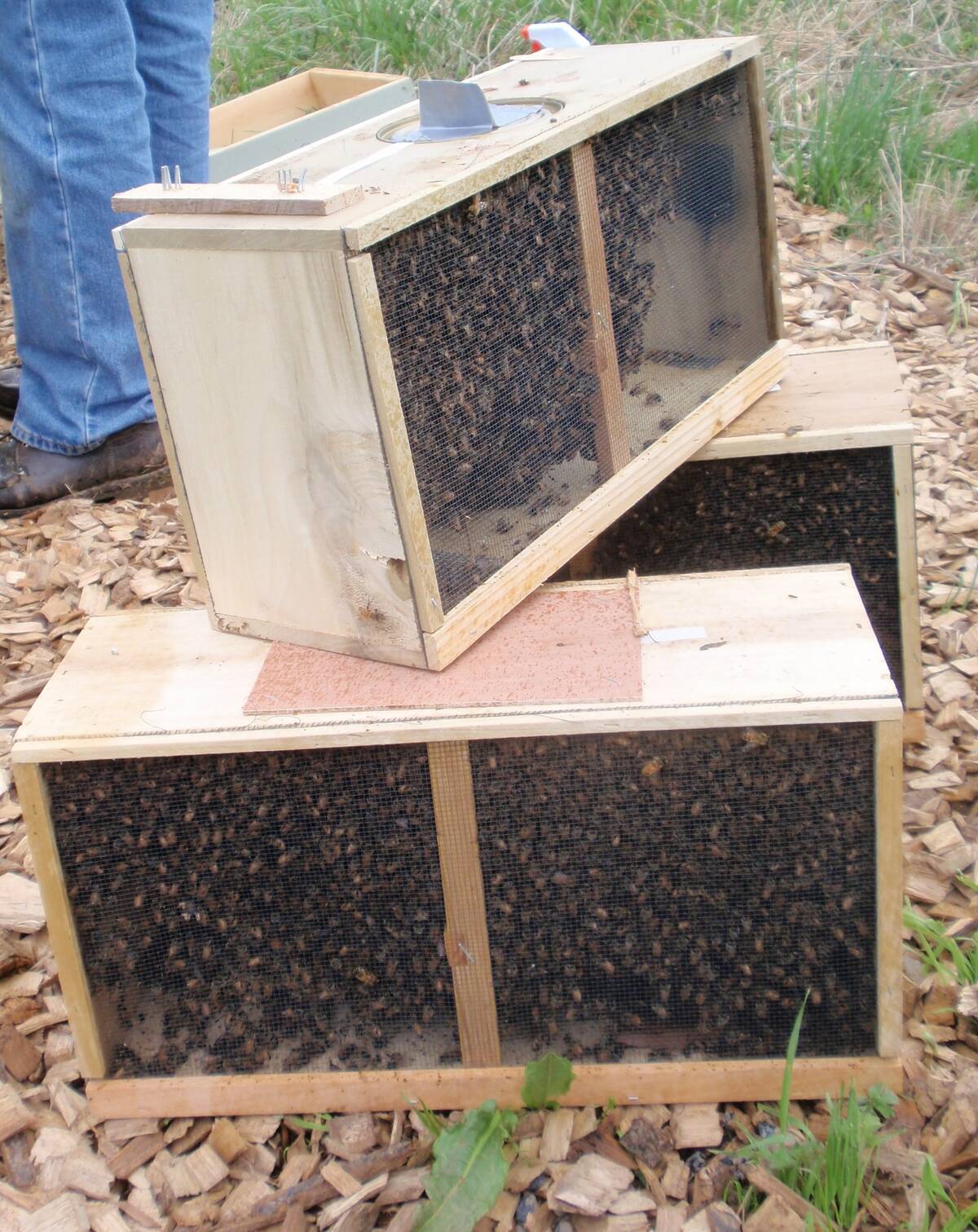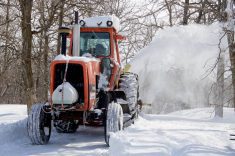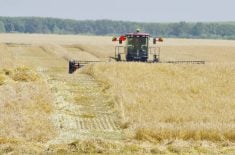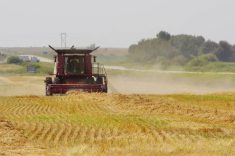Seeding progress has been observed in many areas of the province this past week and is now at 64 per cent complete. Producers have focused on planting corn (80 per cent complete), spring wheat (87 per cent complete) barley (79 per cent complete) and peas (96 per cent complete). Canola planting continues with 41 per cent of the acres planted. Soybean planting is at 55 per cent completion. Producers are planting a variety of crops based on soil and weather conditions.
Cereals
Winter cereal fertilizer applications are complete with field survival at 85-95 per cent and only a few fields terminated. Winter cereal stands are growing rapidly and tillering in the warm temperatures with fields greening up dramatically.
Read Also

Canadian beekeepers call for regulatory accountability
Beekeepers say the Canadian Food Inspection Agency should restore packaged U.S. bee shipments, claiming the agency isn’t following evidence.
Cereals in the Central region are the most advanced with much of the early seeded cereals at the five-leaf stage with one tiller.
Spring wheat seeding is at 87 per cent complete, barley seeding is at 79 per cent and oats is at 76 per cent across the province.
Grain corn planting is 80 per cent complete with most of the early planted corn at V3 stage.
Oilseeds
Both canola and sunflower planting is at 41 per cent completion across the province.
Pulses and Soybeans
Field pea planting is at 96 per cent completion across the province, soybean planting is at 55 per cent completion across the province and dry bean planting is at 24 per cent completion across the province.
Forages & Livestock
Forages
Rains throughout the week and over the weekend are stimulating pasture growth and the landscape is green. Hay fields and pasture are both in good shape with standing water in some areas.
Tame hay growth is now up to 16 inches. Pastures and alfalfa are quickly greening up and will make use of the current availability of moisture.
All low-lying areas and ditches have water standing/flowing. Alfalfa stands are about 12-inches tall and dense. Most bromes and ryegrasses are building up steam and tillering.
Livestock
Several beef cattle operations have animals fully on pasture and others are making the move as weather conditions permit.
Most cattle have entered some kind of pastures to avoid the mud which has appeared in the overwintering areas and to make the most of the strong pasture growth. In some cases, there may be enough growth to meet livestock nutritional needs, but supplementary feeding is still taking place on some farms. Producers are checking their fences and carrying out necessary maintenance work ahead of the grazing season. Cattle vaccination is underway. Calving is ongoing but will wrap up by the end of the month.
Dugouts are full and water levels are currently adequate.
Regional Comments
Southwest
A major rain swept through parts of the Southwest region this past week, filling up the soil profile and accumulating in low spots. Most fields are saturated with moisture and temperatures have been generally cooler than normal due to the rainfall events. There were no reports of hail, but there were reports of snow in the Turtle Mountain and Brandon areas.
Seeding for the region is estimated to be 67 per cent complete, with most producers now planting canola, dry beans, and soybean acres. Cereals are 85-90 per cent complete, with the early-seeded crops being at single leaf to three leaf stages in the field, and crops seeded later are just emerging. Winter cereals are at the booting stage.
Peas are 95-100 per cent complete and are at 3-4 nodes on average. Canola is 45-50 per cent complete, soybeans 65-70 per cent complete, and flax at 50-60 per cent complete. Canola and soybeans are on average just emerging, and corn is between emerging to V1. Grain and silage corn are 80 per cent complete.
Flea beetles are present but in low numbers so far, and there are no reports of any grasshoppers yet. There are some reports of unexpected gopher damage in crops this year.
Rainfall has brought on a strong flush of weeds. Wild oat is present at two leaf stage, kochia the size of dimes, buckwheat at two leaf, green/yellow foxtail at single leaf and emerging, roundleaf mallow at 2 leaf, winter annuals like flixweed and foxtail are rather large now and flowering or booting, and downy brome has headed out.
Northwest
Frequent rains and cooler weather made for a slower week of progress. Unsettled weather Friday brought precipitation in forms of rain/snow. Swan River and The Pas precipitation was mainly rain, while the rest of the region experienced snow. Accumulated rainfall from the week has left some areas with standing water in fields. Highest accumulated amounts of precipitation were in the McCreary and Amaranth regions with 66 mm. Lowest precipitation amounts for this week was The Pas with 6 mm. Some hail was reported in the Roblin area. The recent precipitation has caused excess moisture concerns in the Dauphin/Ste. Rose/Grandview areas. Warm, dry conditions are needed as there are seeded and unseeded fields with surplus moisture.
Plant growth in recently emerged crops has been slow due to cool temperatures. Weed and volunteer growth is slower as well. Herbicide applications will be a challenge in areas due to saturated field conditions. Overall seeding progress across the region is at 56 per cent compete.
Field pea seeding has pretty much wrapped up with progress approximately 99% complete. Earliest seeded field peas are beginning V2 stage. Later seeded field peas are emerging.
Spring wheat seeding is 80-85 per cent complete. Earliest seeded wheat is emerged and growing nicely.
Canola seeding progress is slower this week and is at 30 per cent complete. Some of the earliest seeded canola has emerged and is at cotyledon stage. Soybean seeding progress is at 35 per cent complete. Winter wheat and fall rye crops are growing nicely, however there was some reseeding due to winterkill.
Central
The Central Region received substantial precipitation over the weekend, with the western areas of the region receiving it mainly as snow. Across the region, many fields were left with patches of standing water in them. The degree to which fields were affected varied greatly due to topography, soil type and the volume of rainfall received. Producers across the region are draining water off fields where possible. This process has been made difficult where ditches remain full. In areas where moisture could leave fields or infiltrate quickly crop damage should be minimal. Producers are monitoring the situation in the most extreme cases to determine if any reseeding may be necessary.
Seeding had progressed prior to the precipitation events with spring wheat, barley, and oats estimated at 92 per cent complete. Much of the early seeded cereals are at the five-leaf stage with one tiller.
Field peas are emerging and the earliest seeded have reached the two to five leaf stage. Soybean planting is 65 per cent complete, with seedlings starting to emerge. Some of the earliest edible beans were planted ahead of the rains this week and are at 30 per cent complete.
Canola seeding is at 55 per cent complete and the earliest planted has reached the cotyledon stage. Flax is 90 per cent planted, with most of the crop now emerging. Sunflower seeding progress is at 60 per cent, with the earliest now at the cotyledon stage. Silage and grain corn are at 80 per cent complete, with most of the early planted corn at the three-leaf stage. Potato planting is approximately 85 per cent, with the earliest fields just beginning to emerge. Dry bean planting is approximately 30 per cent complete.
The proportion of each crop seeded varies greatly at the local level across the region, with percentage of crops in the ground generally lowest in the north around the RM of Portage la Prairie, and highest around the RMs of Rhineland, Montcalm, and Stanley.
Eastern
Rainfall accumulations across the Eastern region last week ranged from 30 to over 50 mm with severe downpours in some localized areas resulting in higher precipitation. Most of this rainfall occurred on Friday and Saturday of last week. Standing water remains evident in fields across the region with low lying areas more extensively flooded. In lower rainfall areas some receding of standing water has become evident over the last 24 hours but fields in all areas are thoroughly saturated and inaccessible.
Given the weather conditions, producers struggled to make progress on seeding, spraying and field work activities. Fields remained off limits for some last week while others had access for a limited time although seeding conditions were not ideal. Producers worked around wet areas of fields and monitored their land carefully to not miss opportunities to make progress. Producers will have to remain off fields for much of this week. Those who experienced lower amounts of rainfall are hoping to get at least limited access to better drained fields by the end of the week and are making plans accordingly assuming good drying conditions going forward. While standing water is evident in fields, it is too early to assess how much damage, if any, has occurred to emerged plant stands and whether reseeding will be necessary. A great deal depends on the weather this week. Some producers were out making impromptu drainage channels with all-terrain vehicles and tractors over the weekend to try and speed up field recovery.
Winter cereal stands continued to grow well with stem extension advancing rapidly on most fields. Crop conditions were mostly good with herbicide applications about 70 per cent complete until weather halted progress. Overall, spring seeding was around 70 per cent complete across the region although individual producer progress varied from some not started to others who finished up early last week. Approximately 90 per cent of spring wheat and oats are seeded and barley seeding is complete. Early seeded wheat was in the two to three leaf stage with tiller. Delays in field access could see the remaining spring wheat and oat acres get switched to other crop types. At this point, about 80 per cent of grain corn was seeded and unplanted corn acres may soon be switched to other crop types. Some earlier seeded corn was in the V1 stage.
Approximately 60 per cent of soybean acres, 75 per cent of sunflower acres and 55 per cent of canola acres were planted across the region by the time field operations were shut down last week. Given the challenges with field access, remaining sunflower acres may be switched out for other crop types. Soybean acres may also be reduced although producers will be putting a lot of emphasis on getting remaining soybean acres planted as conditions allow. Total canola acres may see an increase with producers and agronomists viewing canola as the go to switch crop when looking for a home for unseeded acres. Some reports of canola emerging and in the cotyledon growth stage.
Interlake
Most areas in the Interlake region reported rain and cool temperatures last week. Rain seemed to occur each day of the week with the highest amounts occurring in the South Interlake region. Rainfall accumulations ranged from 35- 52 mm with the majority coming between Friday and Saturday. Wet conditions are still the major problem in areas of the region, sunny weather conditions on Sunday were inadequate for drying.
Seeding progress was made last week until Friday and Saturday’s rain. Seeding will be stalled until fields are dry enough to access. Standing water has been noted on some fields.
Progress is more advanced in the South Interlake with some variations in seeding progress due to soil conditions and locations. Growers in Riverton and north of Arborg have not seeded since May 14. Some producers in this area have stated they won’t be seeding again until sometime in June.
Across the region overall seeding progress is 48 per cent complete. Cereals are about 70 per cent complete, corn at 80 per cent and soybean at 25 per cent. Canola is about 20 per cent complete. Early seeded wheat is at the two-leaf stage, with a few reports of early 3-leaf stage. Emergence appears relatively even. Barley and oats are emerging to early two leaf stage.















